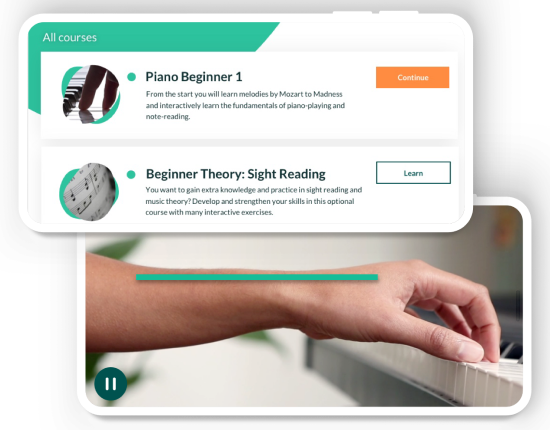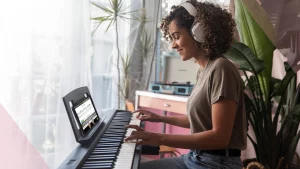Learning to play the piano offers you wonderful opportunities for personal expression and enjoyment. Balancing this with familiarity of the most common mistakes on piano empowers you to speed up your progress!

1. Placing note accuracy above all else
It is not only about playing the right note at the right time. Pianists move between prioritizing:
? Accuracy of notes
? Listening skills
? Technique
A keen ear is developed by keen listening. At first, it will be easier to repeat a song three times focusing on one type of listening at a time.
? Bill Wither’s “Lean on Me” in Skoove’s Piano Songs Beginner Course is a good one to use.
1. Listen for note accuracy
2. Listen to the quality of the sound being produced
3. Listen to the body – hopefully shoulders, wrists, jaw are free from tension and moving with ease.
A good technique gives a beautiful sound.
? (Re)visit the lesson on hand and sitting position in the Beginner 1 Piano Course for a reminder on good posture:
Develop technique by focusing on areas of the body in turn, include wrists, arms, fingers, shoulders, neck. Look for ways to make flexible, coordinated and controlled movements.
2. Reading by finger numbers or keyboard image
One of a pianist’s chief goals is to develop the ability to read music. Too much reliance on the keyboard image or finger numbers can hinder the development of note recognition and pattern reading. (Pattern reading is recognizing whether the music notation is moving up or down or whether it is moving by step or by leap). At first, you may watch the keyboard more than the notation. However, the next step involves turning your attention to the notation and working with this until the piece can be played just as well from the music notation.
Learn more about How To Recognize Notes Quicker.
3. Looking down at the keys too often
Ultimately, pianists keep their eyes on the music only glancing down occasionally to spot a note. For learners, the temptation is to look down to check note accuracy before playing. With Skoove, pianists have a huge advantage in knowing exactly how the piece should sound. Therefore, they don’t need to make the visual correction by looking down, they are alerted to an incorrect note by the Skoove app or their ear.
4. Moving on too soon
Learning continues, after the notes of a piece have been mastered, in the experimentation stage. This comes naturally to younger learners (recall a young child doing the same puzzle repeatedly). In comparison, adults frequently skip this stage, not aware of what they are losing out on. Piano mistake number 4 gives permission to indulge in some creative, obsessive playing. Include experimenting with different speeds, different volumes (dynamics), with added notes or anything else engaging.
Some pieces become favorites; pianists who play these regularly to family and friends develop their repertoire and performing skills.
5. Waiting for the right mood to practice
The best way to get down to regular practicing is to make it a daily non-negotiable, much like brushing teeth. The most efficient learners set a daily minimum amount and do it without question. Some days they do more and other days the daily minimum is a squeeze, but it is done!
Practicing becomes enjoyable and rewarding to those who do it regularly. Their routine is driven by habit rather than mood. That way if frustration or distraction threaten to derail a piano journey, a routine is in place to keep them on track.
A final word
“The only real mistake is the one from which we learn nothing.” ― John Powell.
Recognizing piano mistakes is the first step. Taking the time needed to discover the best correction is where the deepest learning lies.
More beginner tips:
- Beginner tips for good piano posture
- Three technical piano warm-up exercises for beginners
- Bass clef notes: how to easily read notes for the left hand on piano?
Author of this blog post:

Roberta Wolff started piano lessons at the age of five and is still enjoying learning! Currently, she teaches piano pedagogy and performance pedagogy at post graduate level in the UK. Her other work includes running a private teaching practice for students of all ages and abilities and creating learning and practice resources. Roberta loves writing as a means to supporting others on their piano journey.














